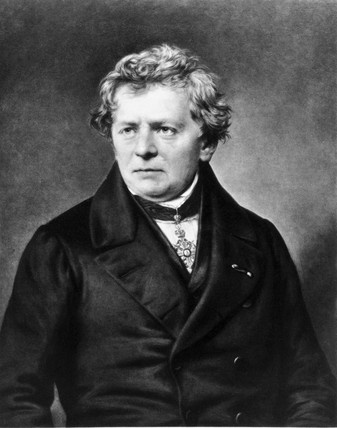Ohm’s Law is an empiric relation, accurately describing the conductivity of a material. It defines the relationship between the electric current passing through a circuit and the potential difference between two points of the circuit.
Index
History
Ohm’s law was named after the German physicist Georg Simon Ohm published a treatise in 1827, that described the measurements of applied voltage and current through simple electric circuits.

Ohm’s Law Explained
Statement
The law states that current passing through a conductor between two points is directly proportional to the voltage across the two points.
Mathematical Equation
\(I \propto V\)
\(I = \frac{V}{R}\)
Where,
\(I\) – Current passing through the circuit/conductor (amperes, A)
\(V\) – Voltage difference between two points (volts, V)
\(R\) – Resistance of the conductor material(ohms, Ω)
The law can also be used to say that the resistance of a wire remains constant, independent of the current. Although the law describes conductivity of various electrically conductive materials, some materials do not obey the law. Such materials are called non-ohmic materials.
The law also depends on the temperature and other physical factors to be constant.
The Ohm’s law is also generalised in electromagnetics in the form:
\(J = \sigma E\)
Where,
\(J\) – Current Density at a location of a material
\(\sigma\) – Conductivity
\(E\) – Electric field at that location
Limitations of Ohm’s Law
Ohm’s law, unfortunately, cannot be applied to unilateral networks. This is because, in unilateral networks current flows in only one direction.
The law is also not applicable to non-linear elements due to changes in resistance, when the voltage or current is changed.
Applications of Ohm’s Law
- This law can be used to determine the voltage, resistance or current of an electric circuit, provided the other two values are known.
- It is used in DC ammeters.
- The power dissipated from various electric appliances can be determined using Ohm’s law.
Examples
Question 1. Resistance of an electric appliance is 20 Ω. Current passing through the appliance is 4A. Find the voltage between any two points.
Solution. As, \(V= IR\)
⇒ \(V = \frac{I}{R}\)
⇒ \(V = 20*4\)
∴ \(V = 80V\)
Question 2. What will be the new resistance of a wire, if it is stretched 4 times its original length?
Solution. Let the original resistance by \(R\) and the new resistance be \(R_{\mbox{new}}\). Let original length of wire be \(l_1\), area of cross section of wire be \(A_1\). Let the new length be \(l_2\) and area of cross section be \(A_2\).
As,
\(R = \rho \frac{l_1}{A_1} … (1)\)
⇒ \(R_{\mbox{new}} = \rho \frac{l_2}{A_2} = \rho \frac{8l_1}{A_2} … (2)\)
Even though the wire is stretched, its volume remains the same.
⇒ \(A_1 l_1 = A_2 l_2\)
⇒ \(\frac{A_1}{A_2} = 4 … (3)\)
Dividing (1) by (2),
\(\frac{R_{\mbox{new}}}{R} = \frac{\rho (8l_1)}{A_2}*\frac{A_1}{\rho l_1}\)
⇒ \(\frac{R_{\mbox{new}}}{R} = \frac{A_1}{A_2}*4\)
Substituting (3) above,
⇒ \(\frac{R_{\mbox{new}}}{R} = 4*4 = 16\)
⇒ \(R_{\mbox{new}} = 16*R\)
Hence the new resistance is 4 times greater than the original resistance of the wire.
FAQs
Ohm’s law is a relationship between the current passing through a conductor and the voltage difference between any two points on the conductor.
Semiconductors are nonlinear materials i.e., the resistance of such materials change on changes in voltage or current. This is why Ohm’s law is not applicable for semiconductors.
